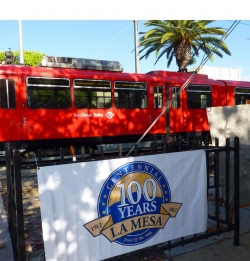"There is nothing more difficult to take in hand, more perilous to conduct, or more uncertain in its success, than to take the lead in the introduction of a new order of things." Niccolo Machiavelli

By Walter Hall
September 1, 2011 (La Mesa)--This second installment of ECM’s three part series on the proposed Property-based Business Improvement District (PBID), examines governance, including the City’s high-visibility role, and the proposed PBID budget. For Part I and readers’ comments, see http://www.eastcountymagazine.org/node/6980.
After months of rumors and lingering concerns about the proposal process, there are signs of PBID fatigue along La Mesa Boulevard. These are offset by growing interest across the district and into the larger community. La Mesa residents do have skin in the game, regardless of their street addresses--not least because the City is about to commit approximately $60K of tax dollars to fund PBID operations.
The stakes are plain. A secure, walkable downtown with vibrant shops, restaurants and entertainment venues appeals to everyone. Every La Mesan understands that greater commercial activity increases the city’s overall fiscal health; residents are alert to the converse. When a major economic hub sinks, city services suffer – taking property values down with them.
The proposed PBID and the City’s planned Downtown Streetscape Project are designed to backstop those stakes. The two are not contingent on one another, but they are certainly expected to be symbiotic. That prompts the first question.
Question: What is the Streetscape?

Answer: The most succinct definition comes from the City Manager’s September, 2010 Report to the City Council. It says “The objectives of the Downtown Village Streetscape Improvement Project are to revitalize the downtown area, to enhance its sense of place as a central business district, and to improve public safety.”
The project will attain those objectives by coordinated “replacement and refurbishment of existing pedestrian infrastructure, installation of new streetscape amenities, new landscaping and enhancement of pedestrian linkages.” The list of improvements includes enhanced crosswalks and pedestrian linkages, new pavement, landscaping and street trees, street lights with power outlets and a sound system for special events, Village gateway lighting treatments, street furniture, signage and bollard systems for street closures.
For a partial preview, walk along western Allison Avenue today; for a map and concept drawings, see http://www.cityoflamesa.com/index.aspx?nid=885
That’s the Streetscape. Let’s turn to how a PBID might work in La Mesa.
Q: How is a PBID governed?
A: California law on PBIDs is spelled out in Part 7 of the Streets and Highways Code commonly cited as the “Property and Business Improvement District Law of 1994.” To review the specific sections in Part 7 see: http://codes.lp.findlaw.com/cacode/SHC/1/d18/7
The chain of accountability begins and ends with the City Council. A district is established, after the ballots have been counted, with the Council’s adoption of a Resolution of Formation. A district’s organization submits a report to the City Clerk for each fiscal year, except year one, and the Council may approve the report or modify any particular – thus shaping the work of the district going forward. And it is to the Council that property owners may bring a petition for disestablishment, during the life of the PBID.
In La Mesa, the expectation is that the Formation Committee will become the PBID’s founding Board of Directors, assuming responsibility for the District’s annual reports and creating a 501(c)(6) organization as an oversight and revenue magnifying tool.
The specifics on board elections and terms for board members are still to be determined.
The PBID organization would be staffed at first by an Executive Director. An energetic (not to mention diplomatic) Director will be expected to raise funds, build partnerships, extend awareness, and work in concert with both the City and the La Mesa Village Merchants Association. That’s a tall order. Much depends on astute selection; a bad choice could spell disaster. Even an ideal candidate will face intense scrutiny and perhaps unrealistic expectations. Open recruitment of an Executive Director would be the PBID’s first real challenge.
The Formation Committee is much encouraged by the experience of the Hillcrest organization, which now raises enough money that the annual assessment is just a fraction of the budget. The law allows for changes to the basis and method of assessment year-to-year through the approval of a district’s annual report by the City Council, provided that contractual and debt obligations are met. Fundraising success can translate into lower assessments.
Ultimately, the assessed property owners themselves hold the reins. A district is certified for five years, but the California Streets and Highways Code allows for a 30-day period each year in which the assessees may request disestablishment of the district. The first such period begins one-year after the date of establishment. According to Section 36670 of the Code, “upon written petition of the owners of real property or businesses in the area who pay 50% or more of the assessments levied, the city council shall pass a resolution of intention to disestablish the district.” Upon disestablishment, remaining revenues would be refunded to the property owners by the same measure they were assessed
Q: What is the projected annual budget for the PBID?
 A: The proposed budget is currently set at $378,000 per year. Initial drafts were top-heavy. Supplementary maintenance and security services combined with operations and administration absorbed 80% of the draft budget, leaving very little for promotion, business development and other activities intended to build the future. The imbalance was corrected during the Formation Committee’s deliberations, but the result was a much larger bottom line and renewed worries about scope and suitability.
A: The proposed budget is currently set at $378,000 per year. Initial drafts were top-heavy. Supplementary maintenance and security services combined with operations and administration absorbed 80% of the draft budget, leaving very little for promotion, business development and other activities intended to build the future. The imbalance was corrected during the Formation Committee’s deliberations, but the result was a much larger bottom line and renewed worries about scope and suitability.
It is anticipated that the La Mesa district’s Board of Directors will decide on line item funding, year by year.
The annual report format specified by the Code (Section 36650) requires a district to indicate the method and basis of levying the assessment with sufficient detail so that property owners might estimate the amount to be levied for that fiscal year.
Q: What does that budget cover?
A: The proposed budget is allocated to five broad categories of annual expenditure. First year funds are earmarked as follows: Supplemental Maintenance at $65,000; Security at $60,000; Marketing at $100,000; Special Project and Amenities (such as holiday lighting) at $50,000; and Operations and Administration at $103,000.

What outcomes are these figures intended to secure? Nothing less than full leverage of the City’s planned investments in Streetscape. The objective, say PBID supporters, is to create enough positive energy and activity to revitalize the economy of the downtown area. Advocates are equally emphatic that the PBID is not a substitute for the City’s current obligations.
The City will continue to provide the same services it does today. According to an administration Fact Sheet, if a PBID is formed, the City will execute a Baseline Service Levels agreement with the PBID’s governing board committing the City to current services, whether for landscaping, maintenance or police patrols.
Q: Does the budget address the most pressing needs?
A: There are plenty of questions. Is this budget line enough? Is another line redundant? These unknowns are far more likely to be resolved in practice than in discussion. One issue grants some overdue credit to the La Mesa Police Department. Many observers find the PBID security budget too high, some even say unnecessary, given the performance of the LMPD. The argument that swayed the decision of the Formation Committee has more in common with community assistance than crime fighting.
Taking a page from the “broken windows” approach to neighborhood policing, it targets the insecurity caused not by violent people, not even necessarily criminals, but disreputable, unruly, or unpredictable people. They may be panhandlers, drunks, addicts, rowdy teenagers, prostitutes, loiterers, or the mentally disturbed. In any given area, they are often the first broken window.
Recently, criminologists have suggested that in an era of fiscal constraints, “broken window” policing is not the best use of the police department. The planned PBID security addresses that criticism by leaving the police to focus on violent crime, anti-gang initiatives and high-crime hotspots.
Q: Are the assessments triggered by the budget small business killers?
A: Here are the numbers under consideration. A Zone One (central commercial area) business operating in a 1000 square foot space would be assessed $37 per month, or $444 per year. A 2000 square foot space – more common along La Mesa Boulevard – would be assessed $74 per month, or $888 per year. These figures apply to the property owners. In the case of a tenant business, the calculations assume a direct 100% pass through to the tenant, which may or may not occur.
These are not insignificant sums for small businesses weathering the worst recession in 60 years. But it’s not just the numbers. Several other aspects drive the concerns of PBID opponents. One of them is equity. A PBID is a blunt instrument. Under a veneer of fairness – with the assessment falling equally across like properties – it fails to account for substantial differences among the businesses on those properties, which often have quite distinct operations with varied carrying costs and substantially different margins.
Another question is timing. On a macro level, US consumer spending is anemic. On the micro level, district merchants look askance at the prospect of absorbing a new assessment at the very time Streetscape construction slows the flow of trade. The Formation Committee shares this concern. Ideally, the first assessment would not appear on the property tax rolls until construction is all but complete.
A third issue is scale. No one knows what the perfect mix of PBID services should be. But PBID skeptics are united in the belief that the current proposal is too ambitious--that in taking on too much, too soon it presents a costly and unnecessary risk. When they describe the PBID as a “monstrosity,” it is the disproportion that bothers them – like pounding a thumbtack with a hammer. Not surprisingly, PBID advocates make exactly the opposite argument.
Q: So much hostile fire is directed at questions of process, would the current PBID proposal enjoy greater momentum and face fewer hurdles if that process were seen as beyond reproach?
A: Not necessarily say the critics. Process is still a raw spot. Yet there is a clear consensus among champions, opponents and interested bystanders that the situation downtown today is not optimal, that real civic and economic challenges loom for the area, and that something should be done, soon. But what?
PBID critics argue that any of the alternatives purportedly explored by the original focus group would offer a model better calibrated in reach, timing and budget to the realities of downtown La Mesa and the present business climate. Among those alternatives were a limited maintenance district, a simple Business Improvement District (BID) and a significantly scaled down PBID.
Advocates turn that position on its head arguing that the need is evident, the opportunity is real and in light of the potentially game-shifting projects, such as Park Station, now on drawing boards, this is not the time for half measures.
Q: Is PBID advocacy an insidious form of social engineering? Or is it simply leadership?
A: City officials continue to have a hand, both directly and indirectly, in nudging the PBID proposal along toward a vote. Some critics have argued that this is nothing less than soft-play caciquismo. And that the process is hopelessly compromised by small-town cronyism. But is that fair?
A closer look says no. The line, pro and con, is not simply drawn with La Mesa’s officials on one side and boulevard merchants or property owners on the other. Many merchants applaud the City’s initiative, some expressing regret that a PBID was not undertaken years ago. Even the most outspoken dissenters readily admit to the hope that a district-based organization – in some form, usually less grand – will succeed. They are not refusniks. What thoughtful critics most want is a transparent, inclusive process, not to shut down all such initiatives.
Moreover, whether elected or appointed, City officials have a mandate to think ahead, to anticipate and to plan. In short, to lead. Hammering them for doing that, for drafting a vision for the city’s future, seems both unjust and unbecoming. The proposed vision is fair game. Absent proven misconduct, the people hired by the voters to create it are not. In a nod to Machiavelli, perhaps it’s time to give them a little credit.
So, it’s the vision thing again. High expectations and concrete economic worries now fuel the debate, as the focus shifts to the appropriate scope and scale for PBID activity. And while the PBID proposal labors through the required process, the City continues a parallel search for the $5 million needed to bring the full Streetscape design to fruition.
This series concludes, in the forthcoming Part III, with a survey of the community’s conflicting visions on downtown redevelopment in La Mesa, the prospects for a PBID, large or small, and the future of the district it would aim to serve.
Meanwhile, tell us what you think.














Comments
Without The PBID
The $60k that the city is to pay toward the PBID -- that is a yearly fee.
The photos inserted in this article are La Mesa Village Merchants Association events, and have nothing to do with the PBID.
Oh by the way, mark your calendar....
** 2011 Oktoberfest is Sept. 30, Oct. 1 and Oct. 2 **
For more than 40 years folks have been drawn to the village for spectacular events, such as the photos inserted into this article....without a PBID. Using only volunteerism - which truly is a gift of love for our community, the La Mesa Village Merchants Association has done an exemplary job in demonstrating it's purpose, "...to promote the businesses within the village area by hosting special events..."
It has been said by PBID supporters that volunteerism doesn't work. Well it does. When honest, hard working people, motivated with a genuine concern for their neighbors, come together.
This PBID could be the same thing. Shrink it down, don't be so ambitious, don't try to fix EVERYTHING at once.
As a native La Mesan I would really like to see the village untouched by progress. It's more valuable to maintain the old look, the atmosphere of the past. That's not something you can buy once you've lost it. Let's just VOLUNTEER to sweep the sidewalks! It's that simple and TAX FREE.
Walt thinks that his "closer
Walt thinks that his "closer look" has dispelled our contention that the PBID is (in part) an exercise in social engineering. But we who have been much "closer" to it than he know otherwise. In fact, given La Mesa's history of dishonest dealings, it would be surprising if it weren't so.
For details, please see:
http://lamesa.patch.com/articles/downtown-village-pbid-ruthless-designs-...